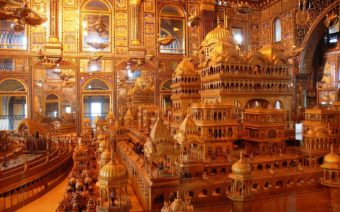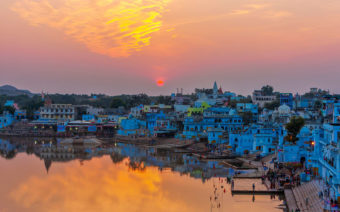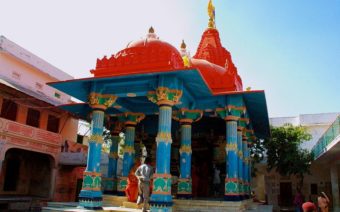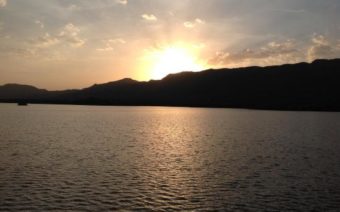
The Ajmer Jain temple, also known as Soniji Ki Nasiyan, is an architecturally rich Jain temple. It was built in the late nineteenth century. The main chamber, known as the Swarna Nagari “City of Gold”, has several gold-plated wooden figures, depicting several figures in the Jain religion. Greatly revered by the Digambar sect of the Jains, the Nasiyan temple is dedicated to Lord Rishabhdev, first of the 24 tirthankara by Rai Bahadur Seth Moolchand and Nemichand Soni. It is situated on Prithvi Raj Marg in Ajmer, the heart of Rajasthan state in India. The foundation of this magnificent Jain temple was laid on 10 October 1864 and the image of the first Tirthankar Lord Rishabhdev (Adinath), was installed in the Sanctum Sanctorum on 26 May 1865. This work was carried out under the able guidance of the great scholar Pandit Sadasukhdasji of Jaipur. But the hidden gem in Ajmer is Soniji Ki Nasiyan aka Lal mandir that was built over 100+ years back by a rich Jain businessman or a Seth. What you see here is a huge hall 90 ft X 65 ft X 92 ft in dimension, with a diorama of a complete Jain city Ayodhya Nagari. At the time of the birth of a Jain saint Adinath. There is a complete 3 storied palace built with scenes depicting the life of the city. The huge armies of elephants and horses are depicted on the ground. There are devas or demigods on their planes coming to visit the earth at the city of Ayodhya made holy by the birth of the saint Adinath. The walls adorn the glass paintings showing scenes and stories from the Jain scriptures.
The whole aura is of grandeur, divinity, and celebration. It is said that the models were created and showcased in Jaipur before they were brought here. You can view this huge piece of sculpture only through a small opening in the walls of the hall. And that too through a glass. But for the security reasons, you want to step inside and feel like how a literally golden city would be. For some reason, I had never heard of this place until I actually landed in front of it. This was the hidden surprise of this trip of mine.
Lake Foy Sagar is an artificial lake situated near Ajmer in the state of Rajasthan, India. It is named after the engineer Mr. Foy, an Englishman, who created it under a famine relief project in 1892. He created it to tackle with harshest conditions of famine under a famine relief project. It appears flat and offers views of the neighboring Aravalli mountains. The lake is among the tourist spots of the city.
At the time when the lake was constructed, the city of Ajmer was known as Ajmere, as can be noticed from the inscription installed at the lake. Its original capacity is 15 million cubic feet, and the water is spread over 14,000,000 square feet (1,300,000 m2). Ajmer was called Ajmere when it was made with a specific purpose, which is now a well-known tourist spot. The place is a famous picnic spot for the local residents during winters.

Ajmer is one of the major and oldest cities in the Indian state of Rajasthan and the centre of the eponymous Ajmer district. It is located in the centre of Rajasthan. Ajmer is surrounded by the Aravalli mountains. It is the base for visiting Pushkar(11 km), an ancient Hindu pilgrimage city, famous for the temple of Lord Brahma. Ajmer has been selected as one of the heritage cities for the HRIDAY- Heritage City Development And Augmentation Yojana. South of the city’s artificial Ana Sagar Lake in Ajmer Sharif Dargah, the domed shrine of the Muslim Sufi saint Garib Nawaz. Nearby, a 16th-century palace built by the Mughal emperor Akbar now houses the Ajmer Government Museum, displaying armour and stone sculptures. A museum at the Indo-Saracenic–style Mayo College exhibits art and taxidermied birds. Although Ajmer Sharif Dargah, the shrine of Khwaja Muin-ud-din Chishti, remains as the most famous tourist places to visit in Ajmer, the city is also significantly known for the Jain religion and is home to an amazing golden Jain Temple. Places to see in Ajmer are Pushkar, Taragarh Fort, Ajmer Shariff dargah, Akhbari fort and museum, Nareli Jain temple, annasagar lake, the lake of Foy Sagar and Prithviraj samarak.

Pushkar Lake or Pushkar Sarovar is a sacred lake located in the town of Pushkar in Ajmer of the Rajasthan State of western India. It is a sacred lake of the Hindus. The Pushkar Lake is one of the most prominent spots of pilgrimage as well as the site of the world famous Pushkar Fair. Encircled by numerous temples and ghats. The lake draws thousands upon thousands of devotees every year to its threshold to gain spiritual distinction and attain salvation by taking a dip in its holy waters. The lake has incredible historical and religious significance. Its significance is mention in several Hindu Texts and sources and is primarily associated with Lord Brahma, who is considered as the creator out of the trinity of Gods- Brahma, Vishnu & Mahesh. According to most versions of the legend associated with the lake, when Lord Brahma killed demon Vajranabha, three petals of His divine lotus fell at three parts, creating springs in their place, known as Pushkar. Later on, Brahma also performed a yagna at the place. However, at the end of this ritual, he got cursed by his first wife that, he will be worshipped at this spot only. The lake is one of the holiest sites for Hindus and the place is accessed mostly for religious purposes only. The lake is surrounded by 500 temples and 52 ghats with different religious significance. People from all across the country and from all walks of life come here to take a dip in its sacred waters. It is said that taking a bath in Pushkar during Karthik Poornima (Full Moon Day), in the month of Karthik i.e October- November assumes special importance as it is considered highly auspicious. It is also said that taking a bath in this lake during Kartika washes all sins and absolve the devotees of bodily ailments especially skin diseases. The Lake has been marked as one of the ten most religious places in the world and one amongst the five top sacred places for Hindus in India. The site is also home to the world’s only Brahma Temple. The ambience and spiritual atmosphere at the ghats is amazing and offers a close understanding of Hindu beliefs and practices.

Pushkar is a town bordering the Thar Desert, in the northeastern Indian state of Rajasthan. It’s set on Pushkar Lake, a sacred Hindu site with 52 ghats (stone staircases) where pilgrims bathe. The town has hundreds of temples, including 14th-century Jagatpita Brahma Mandir, dedicated to the God of creation, which has a distinctive red spire and walls inlaid with pilgrims’ silver coin. Its been the rare temple because it’s amongst the very few existing temples of Lord Brahma in India. It is constructed in the 14th Century and however Indian Mythology believes the origin of this temple took place 2000 years back in history.
The Temple is located close to the sacred Pushkar Lake, the temple is a highly prominent tourist attraction; with a large flock of tourists visiting it especially on the auspicious occasion
of Kartik Poornima. The architecture of the famous Brahma temple in Pushkar is an altogether marble structure and sports a Southern style of temple architecture. Built on a raised platform, the temple’s entrance which is decorated of pillared canopies has to be reached through marble steps. If you want to experience the ultimate devotion towards Lord Brahma, you should schedule your Pushkar trip between October to November. During this month, on the night of Kartik Poornima, as it is the full moon night, a religious festival is organized in honor of the Lord. During this time thousands of pilgrims take bath in the sacred lake of Pushkar. The Kartik Poornima festival also marks the start of the world renowned Pushkar Camel Fair.







